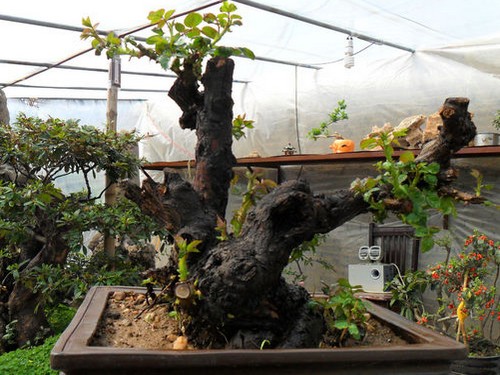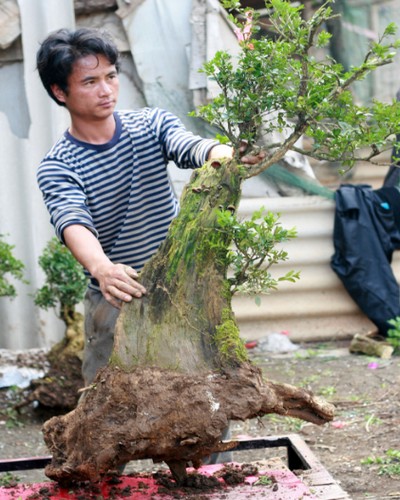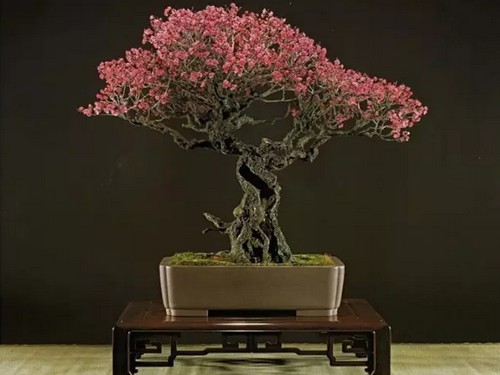Field Stacking and Grafting Techniques of Ancient Stump Rose Bonsai
Every spring to the hillside, ditches to dig the pile type strange, natural end of the wild rose pile. After the pile is harvested, the root trunk is cut in place as far as possible, planted with a little sawdust in plain sandy soil, and can be planted in pots. The whole pile is covered with plastic bags. After the new buds grow 3-5cm, the plastic bags are removed in cloudy and rainy days, and then the stems and leaves are sprayed with water every morning and evening to ensure survival. Fertilization can be started in August, once every half month, with cake fertilizer and water as the best. The branch transition is natural, the next spring to prune, strengthen management, and so on when the new branches grow to a certain thickness, you can start grafting. Individuals who need to be dried can continue to be stocked.

After the pile picking is completed, the interception of the root stem should be in place, and a little sawdust can be infiltrated into the plain sandy soil when planting, and the whole pile can be covered with a plastic bag. After a new bud of 3-5 cm is grown, the plastic bag will be removed on a rainy day, and then the leaves and stems should be watered every morning and evening. Starting from August, fertilizing is carried out every semimonthly, and it is best to use cake fertilizer and water.
The normal growing branches need to be pruned in the next spring, and the management should be strengthened at the same time, so that the new branches can be grafted with a certain thickness.
Bud grafting is a common grafting method of bonsai rose, which can be carried out from May to September with relatively simple operation and more time selection. At the same time, the survival rate is high. Being able to repeat grafting in the original position is also a major advantage of this method.
The flower color and variety of the grafted rose can be chosen according to personal preference. Miniature rose is recommended as the first choice for grafting. This variety has the characteristics of small plants and flowers, large number of flowers and long florescence.
There are three steps to help you improve the survival rate of rose grafting:
1. Select buds
Buds should be selected from strong branches, and the best time is in the early stage of budding. Fertilization is preferred after cutting flowers, and budding buds are selected and grafted after a week of stocking.
2. Sprouting
Rose usually uses the method of peeling and sprouting. However, the micro rose branches are relatively fine, so it is necessary to cut the bud branches into about 2 inside and grow, cut obliquely from the middle of the back of the bud to both ends, then peel off the cortex along the bottom of the bud, slowly peel off the xylem, and the vascular bundles in the bud must be well protected. After taking the bud, the two ends of the bud should be cut flat according to the height of the cut of the rootstock, put the cut of the rootstock gently, stick to the xylem of the rootstock, and wrap it tightly with plastic strip to expose the bud.
3. Moisturizing
After grafting and bandaging, the grafted bonsai rose can be cultivated in the plastic greenhouse, or maintained in the natural environment with a single branch covered with plastic bags, and the plastic bags can be removed and untied after 7-10 days. Appropriate repair can be carried out according to the survival situation.
After a large number of studies and experiments, the perennial Rosaceae plant mountain incense was selected as rootstock, different colored rose branches were selected as cuttings, and various promotion and control techniques such as cutting, root cultivation, stem cultivation, grafting, pruning, shaping and so on were comprehensively used. a tree-like rose with distinct trunk and multi-color flowers can be cultivated.
Time: 2019-06-02 Click:
- Prev

Methods and matters needing attention of picking piles in bonsai field
The classification of tree stump bonsai should include wild stumps and seedlings. The former is the bonsai made by mining wild piles, which is mainly characterized by old and simple, while the latter refers to the bonsai produced by artificial cultivation, which is mainly characterized by rigorous layout, and the two can not be confused. To dig tree stumps in the field, first make preparations before digging.
- Next

Material selection and cultivation methods of miscellaneous wood bonsai
The miscellaneous wood in bonsai refers to the artistic processing and modeling of bonsai based on the ancient alpine trees in nature, so as to achieve the purpose of shrinking the dragon into an inch, and cultivate it into works of art derived from nature and higher than that of nature, which is a non-renewable resource. Next, I would like to introduce the selection and cultivation methods of miscellaneous wood bonsai.
Related
- Fuxing push coffee new agricultural production and marketing class: lack of small-scale processing plants
- Jujube rice field leisure farm deep ploughing Yilan for five years to create a space for organic food and play
- Nongyu Farm-A trial of organic papaya for brave women with advanced technology
- Four points for attention in the prevention and control of diseases and insect pests of edible fungi
- How to add nutrient solution to Edible Fungi
- Is there any good way to control edible fungus mites?
- Open Inoculation Technology of Edible Fungi
- Is there any clever way to use fertilizer for edible fungus in winter?
- What agents are used to kill the pathogens of edible fungi in the mushroom shed?
- Rapid drying of Edible Fungi

